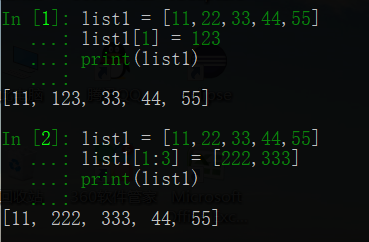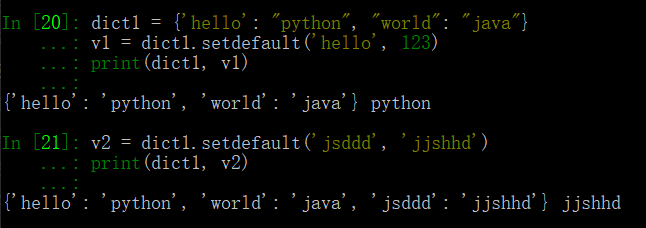python中的列表
# 列表
# list 类,列表
# 中括号括起来 ,逗号分隔每个元素,列表中的元素可以是数字,字符串,列表,布尔值等等。
# 列表还可以嵌套列表
=========列表的基本操作=========
(1)列表的常用操作
list1 = [11,22,33,44,55] # len 查看列表的元素的个数 print(len(list1)) # 通过索引取值 print(list1[3]) # 对列表进行切片 print(list1[0:2]) print(list1[:])
# for循环操作
for i in list1:
print(i)
(2)列表元素,可以被修改
# 1.通过列表索引修改元素 list1 = [11,22,33,44,55] list1[1] = 123 print(list1) # 2.通过列表切片修改元素 list1 = [11,22,33,44,55] list1[1:3] = [222,333] print(list1)
以上的运行结果为:

(3)列表转换成字符串的注意事项:
1.如果列表中既有数字又有字符串时,需要用for循环转换。
# 列表中既有数字又有字符串 list1 = [11,22,33,44,"hello","python"] string = "" for i in list1: string = string + str(i) print(string)
运行结果为:

2.如果列表中只有字符串,列表转换成字符串可以用join方法
list1 = ["hello","python"] v1 = "".join(list1) print(v1)
运行结果为:

============列表的常用方法=========
list1 = [11,22,33,44,55] # 1.append 追加元素到列表,也可追加列表 v1 = list1.append(235) print(list1) # 2.clear 清空列表 list1.clear() print(list1) # 3.copy 拷贝,浅拷贝 list1 = [11, 22, 33, 44] v1 = list1.copy() print(v1) # 4.计算元素出现的次数 v1 = list1.count(11)
print(v1) # 5.insert 在指定索引位置插入元素,有两个参数,参数一指定插入的索引,参数二参入的元素 list2 = [11, 22, 33, 44, "hello", "python"] list2.insert(1, 99) print(list2) # 6.列表的删除操作 # remove 删除列表中指定的元素 list2.remove(22) del list2[1] # 通过索引删除 del list2[1:5] # 通过切片删除 # pop() 删除某个值,并获取删除值,没有指定索引,默认删除最后一个元素 # v1 = list2.pop(1) # print(list2) # print(v1) # 7.extend 扩展原来的列表,必须是可迭代对象(内部执行了for循环) list2 = [11, 22, 33, 44, "hello", "python"] list2.extend([111, 222]) list2.extend("hello") print(list2) # 8.reverse,对当前列表进行翻转 li = [11, 22, 33, 44, 55] li.reverse() print(li) # 9.sort 排序(默认升序排列)sort(reverse=False) li = [11, 23, 10, 24, 26, 39, 73, 55] li.sort(reverse=True) # 降序排列 print(li)
第七题运行的结果:

python中的元组
# 元组,元组不可被修改,不能被增加或者删除
# 一般写元组的时候,推荐在最后加上逗号
# 元组的一级元素不可修改/删除或增加
# 元组用法同列表,切片,成员运算in / not in
# 索引 age = (11, 22, 33, 44, 55) v = age[2] # 切片 v1 = age[0:3] print(v, v1) # for循环 for i in age: print(i) # in or not in print(22 in age) print(123 not in age)
python中的字典
# 字典的value可以是任意值,字典、列表、元组、字符串等。
# 列表和字典不能作为字典的key,元组可以作为字典的key,
# 布尔值可以作为key,但是当有字典的键为1/0时,哪一个在前面,后面的键值对就不显示。
# 字典是无序的
info = {'name': 'egon', 'age': '18', 'sex': 'male'}
# 字典的取值
print(info['name'])
# 字典的删除
del info['name']
print(info)
# 字典的for循环,默认循环输出所有的key
for i in info:
print(i)
# 通过values()方法可以得到字典的values info = {'name': 'egon', 'age': '18', 'sex': 'male'} for i in info.values(): print(i) # for 循环得到key和value for k, v in info.items(): print(k, v)
以上运行结果为:
=============字典的常用方法========
dict1 = {'hello': "python", "world": "java"}
# 1.fromkeys() 根据序列,创建字典,并指定统一的值
v1 = dict.fromkeys(["k1", "999", 123], 111)
print(v1)
# 2.get() 根据key获取值,key不存在时,可以指定默认值(None)
dict1 = {'hello': "python", "world": "java"}
v = dict1.get('hello', 'hadoop')
print(v)
# 3.pop() 删除并获取值
dict1 = {'hello': "python", "world": "java"}
v = dict1.pop('hello')
print(v)
# 删除字典所有元素
v1 = dict1.popitem()
print(v1)
# 4.setdefault() 设置值,已存在不设置,不存在设置,获取当前key对应的值
dict1 = {'hello': "python", "world": "java"}
v1 = dict1.setdefault('hello', 123)
print(dict1, v1)
v2 = dict1.setdefault('jsddd', 'jjshhd')
print(dict1, v2)
# 5.update() 更新
dict1 = {'hello': "python", "world": "java"}
dict1.update({'k1': 1111, 'k2': 999})
print(dict1)
dict1.update(k1=234, k2=3344, k3=9988)
print(dict1)
第四题运行结果为:

python中的集合
# 集合中是由一组无序的可hash值,可以作为字典的key
# 集合由不同的元素组成,并且无序,集合中的元素必须是不可变类型
# 不可变类型:数字,字符串,元组
# 集合也是可迭代类型,可迭代类型还有字符串,列表,元组,集合,字典
# set 定义 s = {11, 22, 33, 44, 55} # add() 添加元素 s.add('hello') print(s) # clear() 清除集合 s.clear() # 集合删除元素 # 1.s.pop() 随机删除元素 s.pop() print(s) # 2.s.remove() # 指定删除集合元素 s.remove(11) print(s) # 3.s.discard() # 删除元素,如果元素不存在,不会报错 s.discard('hello') print(s) print("========================")
# 4.update() 更行多个值 s1 = {1, 2, 3, 4} s2 = {1, 3, 5, 7, 8} s1.update(s2) s1.update((5,6,7,8,9)) update 后面跟的数必须是可迭代类型 s1.add((2, 3, 4, 5, 6, 7, 8, 9)) # add后面跟的数必须是不可变类型 s1.add("hello world") # add() 只能更新一个值 s1.union(s2) print(s1)
# union() 求交集操作,原集合数据不变,update()更新操作,源集合发生变化。
# 5.for循环 for i in s1: print(i)